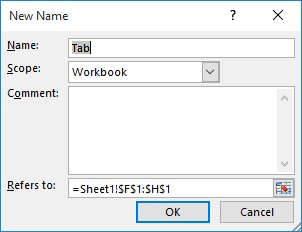Please Note: This article is written for users of the following Microsoft Excel versions: 2007, 2010, 2013, 2016, 2019, 2021, 2024, and Excel in Microsoft 365. If you are using an earlier version (Excel 2003 or earlier), this tip may not work for you. For a version of this tip written specifically for earlier versions of Excel, click here: Returning Item Codes Instead of Item Names.
Written by Allen Wyatt (last updated October 9, 2025)
This tip applies to Excel 2007, 2010, 2013, 2016, 2019, 2021, 2024, and Excel in Microsoft 365
Alan can use data validation to create a drop-down list of valid choices for a cell. However, what he actually needs is more complex. He has a large number of item names with associated item codes. In cell B2 he can create a data validation list that shows all the item names (agitator, motor, pump, tank, etc.). The user can then choose one of these. When he references cell B2 elsewhere, however, he wants the item code—not the item name—returned by the reference. Thus, the reference would return A, M, P, TK, etc. instead of agitator, motor, pump, tank, etc.
There is no direct way to do this in Excel. The reason is because data validation lists are set up to include only a single-dimensional list of items. This makes it easy for the list to contain your item names. However, you can expand how you use the data validation list a bit to get what you want. Follow these steps:

Figure 1. The Data Validation dialog box.
With these steps done, people can still use the data validation drop-down list to select valid item names. What you now need to do is reference the item code from the data table you set up in step 1. You can do that with a formula such as this:
=XLOOKUP(B2,ItemNames,ItemCodes)
This formula will work in Excel 2021, 2024, and Microsoft 365. If you are using an older version of Excel, you can use this formula:
=VLOOKUP(B2,OFFSET(ItemNames,0,0,,2),2,FALSE)
These formulas can be used on its own (to put the desired item code into a cell) or it could be used within a larger formula, anyplace you would have originally referenced B2.
If, for some reason, you cannot create a data table for your item names and codes, you could approach the problem by entering your names and codes directly into a formula. Either of the following will work:
=CHOOSE(MATCH(B2,{"agitator","motor","pump","tank"}),"A","M","P","TK")
=INDEX({"A","M","P","TK"},MATCH(B2,{"agitator","motor","pump","tank"},0))
These formulas work just fine in Excel 2021, 2024, or the Excel in Microsoft 365. In older versions of Excel you'll need to enter it as an array formula by pressing Ctrl+Shift+Enter.
The biggest drawback to the in-a-formula approach is that it can quickly become unwieldy to keep the formula updated and there is a "viability limit" on how many pairs of codes and items you can include in the formula. (The limit is defined by formula length, so it depends on the length of your item names.) Also, this approach is good to only return the item code in another cell, rather than including it as part of a larger formula.
ExcelTips is your source for cost-effective Microsoft Excel training. This tip (12078) applies to Microsoft Excel 2007, 2010, 2013, 2016, 2019, 2021, 2024, and Excel in Microsoft 365. You can find a version of this tip for the older menu interface of Excel here: Returning Item Codes Instead of Item Names.

Professional Development Guidance! Four world-class developers offer start-to-finish guidance for building powerful, robust, and secure applications with Excel. The authors show how to consistently make the right design decisions and make the most of Excel's powerful features. Check out Professional Excel Development today!
Need to know which week of the year a particular date falls within? Excel provides the WEEKNUM function so you can easily ...
Discover MoreThe SUMIFS function allows you to specify criteria by which values can be included in a sum. Putting together the ...
Discover MoreNeed to find the absolute value of a number? That's where the ABS function comes into play.
Discover MoreFREE SERVICE: Get tips like this every week in ExcelTips, a free productivity newsletter. Enter your address and click "Subscribe."
There are currently no comments for this tip. (Be the first to leave your comment—just use the simple form above!)
Got a version of Excel that uses the ribbon interface (Excel 2007 or later)? This site is for you! If you use an earlier version of Excel, visit our ExcelTips site focusing on the menu interface.
FREE SERVICE: Get tips like this every week in ExcelTips, a free productivity newsletter. Enter your address and click "Subscribe."
Copyright © 2025 Sharon Parq Associates, Inc.
Comments